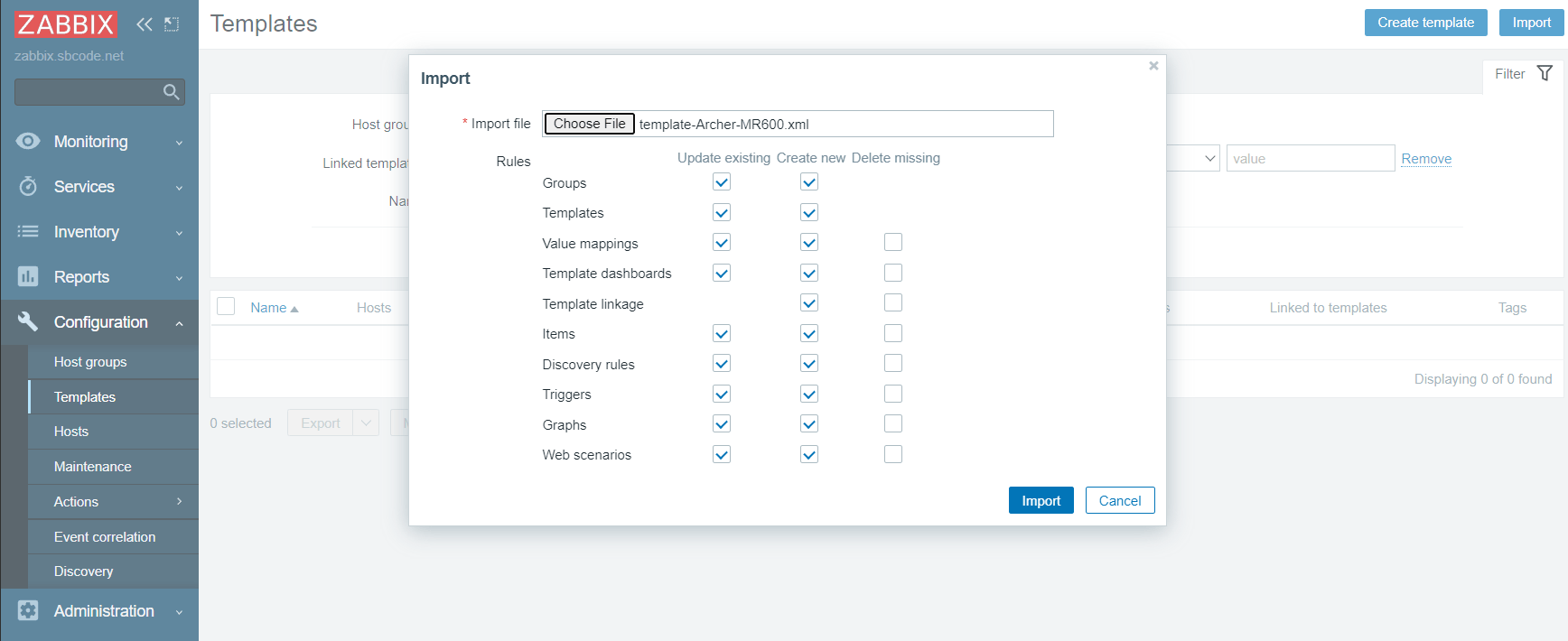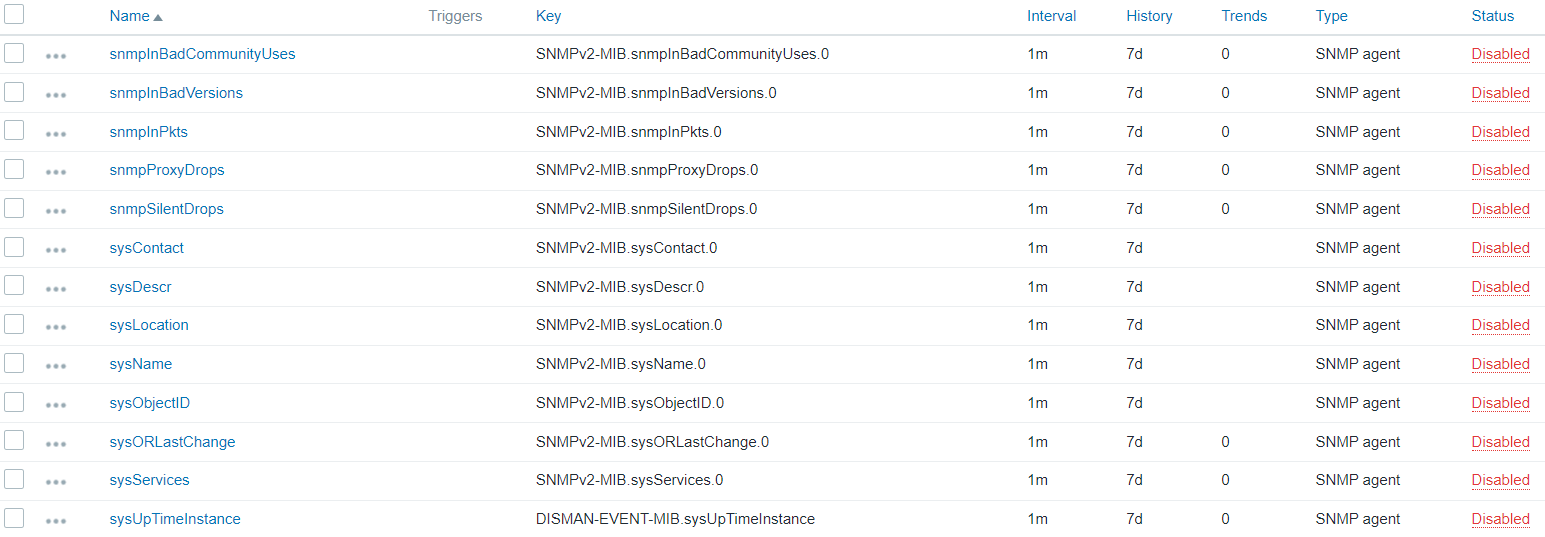SNMPWALK2ZABBIX
Create a Zabbix template from an SNMPWALK response.
NOTE that this script will NOT automatically create a fully featured all bells and whistles perfect template exactly for your needs. It blindly reads the
snmpwalkresponse and tries to create items and discovery rules from what ever it gets back. You will need to edit the result to make it exactly whatever you need it to be. The script comes with no support or warranty. Read the license.
Requirements
- Linux (Tested on Debian 11 and Ubuntu 20.04)
- Python3 (use
python3 -Vto check) - SNMP (uses SNMPv2 to query)
- SNMP-MIBS-Downloader, plus any other custom or proprietary MIBs you may want to use. It will use the MIB descriptions of OIDs as it generates the templates items and discovery rules.
- A working SNMP device that responds to an
snmpwalkcommand - Final template is Zabbix 6 LTS compatible
Download
wget https://raw.githubusercontent.com/Sean-Bradley/SNMPWALK2ZABBIX/master/snmpwalk2zabbix.pyInstall SNMP and SNMP-MIBS-Downloader
The server where you will run the script from, needs the SNMP tools and MIBs. You can get a good set of common MIBs when installing snmp-mibs-downloader on Debian/Ubuntu.
sudo apt update
sudo apt install snmp snmp-mibs-downloaderUsage
python3 snmpwalk2zabbix.py community-string IP-address root-OIDcommunity-string: This is the v2c community name. Most systems default to usepublicas the community name.IP-address: The IP address of the SNMP device that returns a validsnmpwalkresponse.root-OID: Indicates which OID to start creating items from. An OID very low, e.g,1, will result in a much larger template, versus using1.3or1.3.6or1.3.6.1or1.3.6.1.2or1.3.6.1.2.1, etc.
Example
Before using, ensure that you can at least do a simple snmpwalk from the server that you are running this script from.
E.g., I can snmpwalk my network router, and it responds.
snmpwalk -v 2c -c public 192.168.1.1 1.3.6.1.2.1Example output
SNMPv2-MIB::sysDescr.0 = STRING: 1.2.0 0.9.1 v0001.0 Build 201203 Rel.59032n
SNMPv2-MIB::sysObjectID.0 = OID: SNMPv2-SMI::enterprises.16972
DISMAN-EVENT-MIB::sysUpTimeInstance = Timeticks: (292015000) 33 days, 19:09:10.00
SNMPv2-MIB::sysContact.0 = STRING: unknown
SNMPv2-MIB::sysName.0 = STRING: Archer MR600
SNMPv2-MIB::sysLocation.0 = STRING: unknown
... and many more lines
Now to generate the template.
python3 snmpwalk2zabbix.py public 192.168.1.1 1.3.6.1.2.1It will try to produce a Zabbix 6 LTS compatible XML template that you can import.
E.g.,
<?xml version="1.0" encoding="UTF-8"?>
<zabbix_export>
<version>6.0</version>
<templates>
<template>
<uuid>612e6942006545ad90f9962eb1ccce14</uuid>
<template>Archer MR600 SNMP</template>
<name>Archer MR600 SNMP</name>
<description>Template built by SNMPWALK2ZABBIX script from https://github.com/Sean-Bradley/SNMPWALK2ZABBIX</description>
<groups>
<group>
<name>Templates</name>
</group>
</groups>
<items>
<item>
<uuid>5d438a37f38f484fa387a6eb455113fd</uuid>
<name>sysDescr</name>
<type>SNMP_AGENT</type>
<snmp_oid>.1.3.6.1.2.1.1.1.0</snmp_oid>
<key>SNMPv2-MIB.sysDescr.0</key>
<value_type>CHAR</value_type>
<description>A textual description of the entity. This value should include the full name and version identification of the system's hardware type, software operating-system, and networking software.</description>
<history>7d</history>
<trends>0</trends>
<status>DISABLED</status>
</item>
... and many more XML nodesThe XML file will be saved into the same folder as where the script was run. It named my example output file as template-Archer-MR600.xml
Download/Copy/SFTP the saved XML file to a location onto your local computer where you can then import it into the Zabbix UI Configuration-->Templates-->[Import].
My example template for my Archer MR600 router was created with 81 items, and 2 discovery rules.
Here are some of the items it found.
Here are the discovery rules that it created with their item prototypes.
Note that the generated template is not perfect. It is up to you if you want to make it better. The items and discovery rules are created as DISABLED by default. This is to minimize the possibility that assigning this template to a host won't overload your Zabbix server/proxy or your SNMP host/device.
After importing the template, you should review which items and discovery rules that you want enabled. If a MIB description can be found for an OID, then it will use it in the name and description of the item and discovery rule. And hopefully that will make the process of deciding if you want it enabled or not, a little easier.
When you assign your new template to a host in Zabbix. Make sure that your Zabbix server, or Zabbix proxy (if monitored by proxy) can also access your SNMP host/device. I have many Zabbix and SNMP tutorials at https://sbcode.net/zabbix/setup-snmp-host/.
Also note that despite the creation of the template requiring SNMPv2, you can actually still use the resulting template with an SNMPv3 configured host provided that you've configured your host correctly in Zabbix to use SNMPv3. I have some documentation about using SNMPv3 in Zabbix at https://sbcode.net/zabbix/snmpv3-host/
I say again. This script will NOT automatically create a fully featured all bells and whistles perfect template exactly for all your needs. The resulting template may be very large and contain many useless items and discovery rules. You will need to edit the result to make it exactly whatever you want it to be. This script comes with no warranty. Don't forget to read the license.
If you are interested in learning Zabbix to a high level, then I run courses on it. Visit https://sbcode.net/zabbix/ for more information and discount coupons.
Sean







